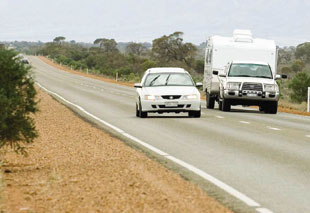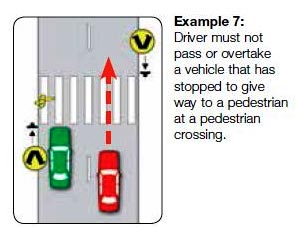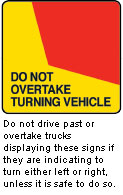The Driver's Handbook
Overtaking

Overtaking is when you approach from behind and pass a vehicle travelling in the same direction.
Most drivers and riders consider overtaking to be crossing to the 'wrong' side of the road to pass a vehicle in front. But, even if you do not cross to the 'wrong' side of the road, you are overtaking if you move into another lane or line of traffic either side of you to pass another vehicle.
Even if you do not cross over to the 'wrong' side, there are some important safety rules you must follow. The rules for overtaking on a multi-lane or unlaned road are similar to those for a single-lane road.
Remember, bicycle riders and motorcyclists are harder to see in traffic and do not have the same protection as drivers. When overtaking bicycle riders allow at least 1 metre clearance, or 1.5 metres when travelling over 60 km/h.
Before overtaking another vehicle, you must:
- be sure it is safe to do so
- on a single-lane road, be sure that the road ahead is clear for a sufficient distance
- be sure you have sufficient distance to return to the same lane or line of traffic without endangering the vehicle being overtaken or any vehicle coming from the opposite direction
- be sure no other vehicle is overtaking your vehicle by checking the road behind in your mirrors and blind spot
- signal your intention to overtake for long enough to give sufficient warning to all other road users.
When you overtake, you must:
- leave a safe gap between your vehicle and the vehicle you are overtaking
- allow a minimum of 1 metre clearance when overtaking bicycle riders; 1.5 metres if travelling faster than 60 km/h
- not return to the lane or line of traffic until you are far enough past the other vehicle to avoid a collision
- not obstruct the other vehicle.
You must not overtake:
- on the right of a vehicle that is turning right, or making a U-turn from the centre of the road, and is signalling to turn right
- on the left, except:
- if the vehicle is turning right or making a U-turn from the centre of the road, and is giving a right-turn signal
- on a multi-lane road, when you are in another lane to the left of the vehicle you are overtaking and the vehicle can be safely overtaken in a marked lane to the left of the vehicle
- on the approach to a children's or pedestrian crossing where another vehicle is stopping or has stopped to give way to pedestrians or bicycle riders (Example 7)

- to the side of a vehicle displaying a Do Not Overtake Turning Vehicle sign if it is signalling and in the process of turning to that side
- if there is a sign saying No Overtaking
- approaching a crest, bend or dip in the road where there is not a clear view for a sufficient distance ahead to allow you to overtake with safety
- on any road where, owing to an intersection, overtaking cannot be completed safely.
- where there is a single continuous dividing line or a single continuous dividing line to the left of a broken dividing line, unless you can do so without any part of your vehicle crossing the line *
- where there is a double continuous dividing line *
* Motor vehicles are allowed to cross centre dividing lines and straddle lanes in order to safely pass bicycle riders at the minimum distance but only if the driver has a clear view of any approaching traffic and it is safe to do so. See examples 4A, 5A and 6A on the Driving on the road page.
Bicycle riders can overtake another vehicle on the left, but not if it is indicating and turning left.
Being overtaken
When driving a vehicle being overtaken by another vehicle, you must:
- keep to the left, if safe, to allow a reasonable space for the overtaking vehicle to pass or
- keep within your lane and
- not increase your speed until the other vehicle has completely overtaken your vehicle and returned to the lane or line of traffic.
Following distance outside of built up areas for long vehicles
Except when overtaking, road trains must maintain at least 200 metres behind another long vehicle and if your vehicle is a long vehicle (7.5 metres or more including any trailer or caravan and any overhanging load), you must keep at least 60 metres distance between your vehicle and any other long vehicle. This does not apply to roads in a built-up area or multi-lane roads.
Overtaking trucks

Unsafe overtaking is something truck drivers see all too often. People can become impatient behind trucks on hills or when there are few passing opportunities.
Some people take a very large risk for only a few seconds' gain.
So allow plenty of room, pass quickly but safely and pull back in, only when you can see both headlights of the truck in your rear view mirror. This allows a safe space, but don't then slow down in front of the truck.
Before attempting to overtake ask yourself the following:
- What will I achieve?
- What are the risks?
- Is it safe and is it legal?
- How far is it to the next overtaking lane?
- What type of truck am I overtaking?
- How long will it take to overtake it?
- Can I see oncoming traffic?
- Is there a bend or dip ahead of the truck that might be obscuring oncoming traffic?
Do not overtake a truck unless:
- You can see oncoming traffic
- You can see there are no bends or dips ahead that may be obscuring oncoming traffic
- You have enough clear distance ahead, without oncoming traffic, dips or bends, to pass safely.
It is also important to avoid being pressured into overtaking by other following vehicles. Keep your cool and if necessary let them pass.
Did you know?
A driver of a car, travelling in a 110 km/h sign-posted speed limit zone, will take approximately 1 kilometre to safely overtake a 23 metre B-double truck that is travelling at 100km/h on a road with an overtaking lane.
On a two-way road with a 110km/h speed limit, you will need almost two kilometres of clear road ahead to safely overtake a 23 metre B-double vehicle that is travelling at 100 km/h as you will have to allow for an oncoming car also travelling at 110 km/h.
You should never overtake a heavy vehicle that is approaching a crossroad. Another vehicle, which is hidden by the truck, could enter the road from the left in front of the truck.































